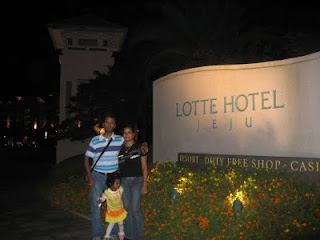Jeju is the largest island of South Korea, which
is created by volcanic eruptions. Jeju is very famous among Koreans and
Japanese tourists because of its mild oceanic climate year round. It’s one stop
destination for many activities like hiking, enjoying beach, horse riding,
diving etc. it’s said that no tour to Korea is complete without visiting Jeju
do.
Jeju
volcanic island and lava tubes are listed by UNESCO as having outstanding
natural significance to the common heritage of humanity. Jeju Island is the
premier tourist destination in Korea because of its stunning natural scenery
and superior tourist amenities. Scenic beaches, waterfalls, cliffs and caves
exist in harmony, while the mild weather makes Jeju Island an even more ideal
tourist site.
There are
two ways to reach Jeju, one by air; Jeju International Airport has several
flights daily via Korean Air and Asiana to Seoul, Busan, Daegu, Jinju, Kunsan,
Gwangju, Mokp'o, P'ohang, Ulsan, Yecheon, and Yeosu. The other option is by
ferry. The ferry terminals at Busan, Yeosu, Mokp’o, Wando, Noktong, and Incheon
on the mainland have daily boats to Jeju city ferry terminals.
 |
| view of Lotte Hotel |
The visitors come to Jeju Island, Korea will suggest to stay at Lotte Hotel whereby this hotel is a famous hotel in Jeju Island. The first
stop on today’s tour is Yongduam Rock, a rock formation that resembles a dragon
head with an open mouth soaring 100m above sea level, creating harmony with the
deep violet-blue sea. Next you will trek the Orum, a parasitic volcano cone on
the top of a mountain where there is a large, deep tunnel-shaped crater (during
the winter, you will visit the Natural History Museum instead).
 |
| Yongduam Rock |
Second day
tour by visiting Cheonjiyeon Waterfall, a three-tiered waterfall surrounded by
lush foliage and also named the Pond of God. To the east there is a cave where
cold water pours from the ceiling to create a waterfall. The water from the
first waterfall becomes the second and third waterfalls and then flows into the
sea. A legend about seven wonder in world and a mountain god is tied to this wondrous
place is known as Miniature Park.
 |
| Cheonjiyeon Waterfall |
 |
| Miniature Park |
The next stop is Gyulimseong, a citrus farm and museum with nearly 1000
wild plants and flowers growing in the basalt volcanic rock. Optional tour: A pleasure boat cruise in
Seogwipo where you can enjoy the view from both above and below the sea. Many
isolated and unexplored regions including islands and Seogwipo’s beautiful
coastal scenery are viewed from the boat.
 |
| citrus farm Gyulimseong |
 |
| boat cruise in
Seogwipo |
Next you
will visit O’Sulloc Tea House, a museum dedicated to green tea. The museum is
the shape of a green tea cup, seeking to harmonize the cultures of the West and
East and past traditions with the modern world.
The tour
will continue to Hallim Park where you can explore Palm Tree Road, Jeju Stone
and Bonsai Garden, the Water Garden, the Subtropical Botanic Garden and much
more. The most famous tourist sites in Hallim Park are Hyeopjaegul and
Ssangyonggul, the only two-dimensional caves in the world. In addition, a folk
village, children's amusement park and outdoor resort facilities make Hallim
Park enjoyable for both children and adults.
 |
| children's amusement park |
 |
| Hallim Park |
The next
place you will visit is Yongmeori (Dragon Head) Shore – an impressive and
beautiful oceanside promenade of soaring, weather-blown cliffs. Note that
Yongmeori closes during very high seas. If this is the case during your visit,
you will visit Sangbanggbulsa, a natural cave overlooking the ocean. Optional
tour: Traditional dyeing experience using natural dyes and fibers.
 |
| Sangbanggbulsa, a natural cave |
 |
| Yongmeori (Dragon Head) Shore |
The third day’s
tour is visit to Dokkaebi Road (Mysterious Road) – a road on which your vehicle
will roll uphill if the vehicle is parked and in neutral. Next you will visit
the Amethyst Factory, where you can see and feel excellent quality Korean
amethyst stones.
Tour will continue to Seonnyeo (nymph) and
Namuggun (woodcutter) Theme Park, comprised of a folk village, old market
street, old shanty house village, an agricultural museum displaying old farming
utensils and an embroidery museum. Seongeup Folk Village is a wonderful example
of Korea’s preserved cultural traditions, including residential houses,
Confucian shrine and schools, ancient government offices, stone statues and
monuments and fortress ruins. Here you can also experience folk plays, native
foods, local craftsmanship and local dialects that have been handed down
through generations. When you explore this area, you like you have traveled
back in time.
 |
| Seonnyeo (nymph) and
Namuggun (woodcutter) Theme Park |
 |
| Seongeup Folk Village |
Last tour
for that day is visit Seongsan Ilchulbong (Sunrise Peak) You will travel 80 km
from your condo to sunrise peak to see the breath taking sunrise. It was really
a wonderful experience.
 |
| Seongsan Ilchulbong |
 |
| way to see Sunrise Peak |
 |
| Sunrise Peak |
The forth
day is to do activity like horse riding farms are very popular in Jeju. One can
take the dress shoes for rent at the shop inside the farm. The horses are well
trained and the trainers walked along with us. It was thrilling to be on a
horse's back and move around.
 |
| horse riding farms |
Next tour
is visit to chocolate museum. The chocolate museum was lots of fun for visitors.
They will saw the procedure of making chocolates and there were many different
types of tempting chocolates on display.
 |
| the chocolate castle |
 |
| making chocolates |



























































